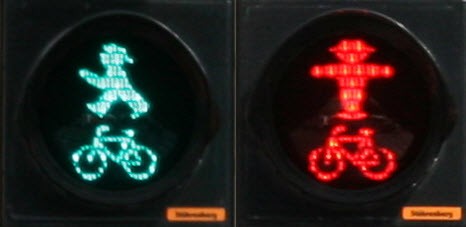
When the New York Police blamed cyclists for causing 75% of accidents -- without offering supporting data, the organization Right of Way struck back with a report showing only 25% of bikers at fault, and that only on the assumption that the drivers responsible for bicycle fatalities testified fairly, in the absence of the victim's point of view. In a Toronto study, a convalescing bicyclist demonstrated that cyclists cause less than 10% of bike/car accidents. The Berlin study delivers another big surprise -- that blows in the face of common perceptions.
So how did a recently released special study of Berlin bicycle safety conclude that almost half of all bike-vehicle accidents and over half of bicyclist fatalities are caused by the bicyclist? Is there any truth to it? And what is the big surprise?
The Results of the Bike Safety Study
The special study on bicycle safety found that although traffic accidents declined 13% for auto drivers, 11% for passengers, and 7% for pedestrians, bicyclist accidents increased 19%. Berlin's Senator Junge-Reyer, in charge of developing city traffic infrastructure, justifies this increase by pointing out that during the same period covered by the study, bicycle traffic increased 30%, a positive trend for sustainable transportation.
The Senator notes that the analysis of all accidents points to failure to obey the rules as the most significant factor in accidents. In the case of bicycle accidents, the study may surprise many by pointing the finger at the bicyclist in 49% of all bike-vehicle accidents, and in 67% of bicyclist fatalities.
The leading causes of bike accidents due to vehicle driver error are incorrect turns, failure to respect right-of-way, and the much dreaded door prize. More interesting are the leading causes of accidents caused by the bicyclists themselves. Since cyclists are seriously disadvantaged in the outcome of the scratch-and-dent versus serious physical injuries scenarios, they should be curious to learn where they are most at risk when safety takes second place to speed.
The Big Surprise
Contrary to what one might be led to believe from auto driver anecdotes, bikes running red lights barely played a role in the accident statistics. Instead, the single biggest cause of vehicle-bicycle accidents is bikes popping up where they are not expected: on sidewalks or riding the wrong direction on bike paths.
In a city where many cyclists are not also drivers, cyclists may be unaware that a driver checking for peds before proceeding may not be looking up the street far enough to account for the speed of movement of a bicyclist. And even drivers who takes care to check for bikes on the bike lane can easily miss a bike coming in the wrong direction.
The Infrastructure Difference
The German Bike Club (ADFC) appeared with Senator Junge-Reyer to support the results of the study. Could one reason bicyclists find the result believable be the fact that few bicyclists are being injured or killed due to poor infrastructure?
It starts with safety in numbers: there are so many bikes on the road in Berlin, that motorists know to stay on the look-out for them. Additionally, major roads generally have a dedicated bicycle path, so bikes do not have to compete for space with cars. Finally, most cyclists in Berlin follow the rules, helped by signs and signals dedicated to directing bike traffic (bikes even benefit from their own stoplights, located at the best height for visibility from a standard bike, and timed for bicyclist safety).
A Risk Worth Taking
Multiple studies support the idea that bicycling risks are more than offest by the increased lifespan associated with regular physical activity. But that does not stop those of us exposed to tons of hurtling steel on wheels from trying to make bicycling, for commuting or sport, safer. And efforts to improve bicycling infrastructure produce more data analyzing accident causes.
Finding fault for accidents between automobiles and bicycles always spurs heated emotions. On the one hand, where should the responsibility be placed when tons of steel strike the exposed human flesh of a pedal-powered two-wheeler? On the other hand, the ire of drivers seethes to the extent that serious biking accidents now include cases like the taxi attack which severed a biker's leg or road-raged drivers targeting cyclists.
But perhaps all sides can learn from the report on cycle safety in Berlin. Rule number one: don't blame the bicyclists when the vehicles have not yet learned to share the streets. Rule number two: don't blame the vehicle drivers when city infrastructure makes it nearly impossible to share the streets safely. And rule number three: obey the rules, especially the traffic rules.
From Treehugger.com

Comments
You should participate in a